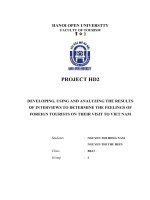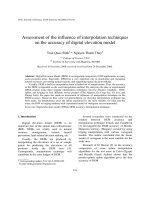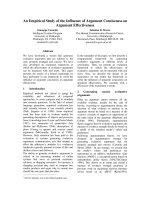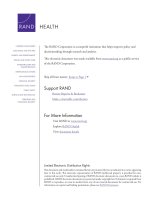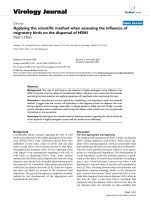The influence of students' beliefs on their speaking performance = tác động của niềm tin đối với khả năng nói của sinh viên yt.PDF
Bạn đang xem bản rút gọn của tài liệu. Xem và tải ngay bản đầy đủ của tài liệu tại đây (572.72 KB, 17 trang )
VIETNAM NATIONAL UNIVERSITY, HANOI
UNIVERSITY OF LANGUAGES AND INTERNATIONAL STUDIES
FACULTY OF POST - GRADUATE STUDIES
****************************************
TRẦN THỊ MIÊN VIỄN
THE INFLUENCE OF STUDENTS’ BELIEFS ON THEIR
SPEAKING PERFORMANCE
(TÁC ĐỘNG CỦA NIỀM TIN ĐỐI VỚI KHẢ NĂNG NÓI CỦA SINH VIÊN)
MINOR M.A THESIS
Field: English Teaching Methodology
Code: 60 14 10
H NI, 2011
VIETNAM NATIONAL UNIVERSITY, HANOI
UNIVERSITY OF LANGUAGES AND INTERNATIONAL STUDIES
FACULTY OF POST - GRADUATE STUDIES
****************************************
TRẦN THỊ MIÊN VIỄN
THE INFLUENCE OF STUDENTS’ BELIEFS ON THEIR
SPEAKING PERFORMANCE
(TÁC ĐỘNG CỦA NIỀM TIN ĐỐI VỚI KHẢ NĂNG NÓI CỦA SINH VIÊN)
MINOR M.A THESIS
Field: English Teaching Methodology
Code: 60 14 10
Supervisor: H CẨM TÂM, Dr.
H NI, 2011
iv
TABLE OF CONTENTS
Candidate’s statement i
Acknowledgements ii
Abstract iii
Table of contents iv
List of abbreviations vi
List of tables vii
Part one: INTRODUCTION
1. Rationale 1
2. The aim of the study 1
3. Scope and Significance of the study 2
4. Methods of the study 2
5. Organization of the study 2
Part two: DEVELOPMENT
Chapter 1: Literature Review
1.1. Concepts of Beliefs 4
1.1.1. The origin of Beliefs 4
1.1.2. Beliefs in Language Learning Study 5
1.1.3. Beliefs about Language Learning 6
1.2. Beliefs about Language Learning Inventory (BALLI) by Horwitz 7
1.3. Speaking Skill Assessment Criteria 11
1.4. Review of Previous Studies 12
Chapter 2: The Study
2.1. Research Questions 14
2.2. Subjects 14
v
2.3. Data Collection Instruments 14
2.3.1. Questionnaire 14
2.3.2. Observation and Note Taking 16
2.4. Data Collection Procedure 16
2.4.1. Questionnaire 16
2.4.2. Observation 16
2.4.3. Records of Learning Results 17
2.5. Data Analysis and Discussions 17
2.5.1. The Students’ Beliefs in Speaking Skill 17
2.5.2. The Effect of the Students’ Beliefs on their Speaking Performance 23
Part three: CONCLUSION
1. Conclusion 29
2. Limitations and Implications 30
3. Recommendation for further studies 31
References
Appendix A 33
Appendix B 38
Appendix C 40
Appendix D 42
Appendix E 44
1
THE INFLUENCE OF STUDENTS’ BELIEFS ON THEIR SPEAKING
PERFORMANCE
PART I: INTRODUCTION
1. Rationale
Vietnamese students have studied English at the early classes since English is
chosen as a compulsory subject at schools by the Minister of Education after a
consequence of the „open door‟ policy. Moreover, English is seen as a means of access to
scientific, technological development and to the world knowledge, as the language for
international communication, and as an instrument for receiving grants and aid. For young
people, English is an effective tool for further study as well as a way to better job
opportunities. Unfortunately, teaching and learning English is still a matter of much
concern due to inappropriate teaching method to develop all skills of students. The fact is
that graduate students even English-major students and non-English major students can not
communicate verbally in English because of shyness, inadequate vocabulary, or simply
lacking the necessary knowledge. There are many reasons for this; for example, during
lectures, Vietnamese rather than English is mostly spoken by both teachers and students.
Besides, students at colleges and universities are mainly just taught by traditional approach
grammar translation method which only concentrates on the ability of using grammar rules
precisely. Listening and speaking skills are ignored. As the results, lots of students rush to
English Language Centers to improve their speaking skill. Also, many students of mine
have come up to me and ask for help in their speaking skill. This main motivation has
urged me to conduct the research.
Another motivation which the study is carried on results from interest of teaching
speaking. By doing this study, I can understand my students‟ beliefs in speaking skill so
that I can have proper methods to orientate them in learning English speaking skill
effectively. All of above factors and reasons have inspired me to do the research on “the
influence of students‟ beliefs on their speaking performance.”
2. The aim of the study
2
The purpose of this study is to see how students‟ beliefs affect their speaking
skill by using the BALLI (Horwitz, 1988) survey instruments. Identification of these
beliefs is to examine whether students‟ speaking beliefs could be linked to their speaking
performance. Moreover, the study recommends some implications for teaching English
speaking skill.
3. Scope and Significance of the study
This paper concentrates on finding beliefs of students in language learning,
especially in learning English speaking. Hence, it examines how students‟ beliefs affected
their speaking performance.
Furthermore, the research may be potential in equipping for modifying speaking
activities in the course book in a more flexible and creative way. By doing survey of
students‟ beliefs, the study might give teachers a profound insight into how to help
students studying English speaking skill effectively.
4. Methods of the study:
The present study was designed to use both quantitative and qualitative research
methods for the analysis. Two major complementary sources of data were used in the
current study. The distributions of a questionnaire of Beliefs about Language Learning
Inventory (BALLI) (Horwitz, 1988) provided quantitative data. The presentations of the
students about given topic were used to elicit the qualitative data.
After collecting the distributions, the questionnaire data will be analyzed in order of
five themes of BALLI (Horwitz, 1988) so as to find out the beliefs of the students in
achieving a good speaking skill. The influence of students‟ beliefs on speaking
performance was examined via students‟ academic marks and their presentations.
5. Organization of the study
The study is organized as follows:
Part one: Introduction presents the rationale, the aim, the scope and significance, the
method and organization of the study.
Part two: consists of three chapters
3
Chapter 1 “Literature review” deals with basic theoretical backgrounds related to
the study. It starts with the concepts of beliefs in language learning. It also presents related
model research of Horwitz (1987, 1988, and 1990) and speaking skill assessment criteria.
Finally, it states previous studies of beliefs about language learning.
Chapter 2 “The study” section 2.1 to 2.4 present the research questions, the information of
subjects, data collection instruments and procedure. Section 2.5 deals with data analysis
and discussions of the students‟ beliefs and its relationship with students‟ speaking
performance.
Part three: “Conclusion” summarizing all the issues in the research contains major
findings, limitations, implications and recommendation for further research.
4
PART II: DEVELOPMENT
CHAPTER 1
LITERATURE REVIEW
1.1. Beliefs about language learning
Some researchers viewed beliefs about language learning as a part of metacognitive
knowledge; however, Wenden (1998) claimed that in second and foreign language
literature, these two terms are used interchangeably to refer to the same construct. The
term, beliefs about language learning, were not clearly defined by researchers in previous
studies. It seems either that the researchers assumed that the term can be understood
intuitively or that the construct is too complex to be operationalized. In most studies, the
term, beliefs about language learning, is used as a known construct without providing
further explanation.
Second language researchers believed that EFL/ESL learners bring their norms,
attitudes, perception and experiences into the learning task process and learning strategies
(Sakui, & Gaies, 1999). Language experts identified that during the process of learning
English as a second/ foreign language, students bring complex issues such as beliefs,
attitudes, norms and expectation into the course syllabus. Based on the related research,
each second language learner has his/her beliefs and thought about language learning and
many factors will have opportunity to affects students beliefs and they can be considered
as affective factors (Hortwitz, 1987). Aptitude, attitude, norms and perceptions have
the potential to affect learners‟ language learning process, their motivation and their
ability to cope with English as a foreign language. Consequently, they can be considered
as push or pull factor to help learners‟ ultimate success in attainment of new language in
shorter time (Bernat & Gvozdenko, 2005). Rod Ellis (2003) indicated that a learner has a
belief about language learning when:
S/he has identified different attributes about language learning and their ability to
learn language, for example, the language they are learning; how best to learn a
language; the importance of learning about the culture of the second language;
whether they expect to be successful.
S/he has evaluated these attributes as positive or negative
1.2. Beliefs about Language Learning Inventory (BALLI) by Horwitz
5
In the early 1980s, Horwitz (1985) developed an instrument for identifying
beliefs about foreign language learning. As Patricia S. Kuntz (1996) maintains, Horwitz‟s
BALLI evolved as a result of a brain-storming session that she had with 25 language
teachers. Horwitz (1988) then compiled a teacher-generated list of beliefs that students
might have about language learning and developed an instrument for her study, which she
called Beliefs about Language Learning Inventory (BALLI) after consulting specialists in
cognitive science and psychology. Three distinct BALLIs are in use today: (1) BALLI to
measure the beliefs of the students of English as a second language (ESL BALLI - 1984,
1987); (2) BALLI to explore beliefs held by foreign language teachers (teachers BALLI -
1985); and (3) BALLI to assess beliefs of students learning foreign languages (foreign
language BALLI – 1988, 1990). The first BALLI consisted of 27 statements and was used
to assess beliefs of immigrants learning English as a second language in Texas. The second
BALLI focused on the beliefs held by teachers of foreign languages; it consisted of 27
statements. The third BALLI comprised 34 statements and was employed by Horwitz to
gather the opinions of students learning French, German and Spanish at the University of
Texas at Austin. All the different versions of BALLIs employed a 5-point Likert scale
ranging from “strongly disagree” to “strongly agree”.
Questions in the BALLI were divided into groups according to their theme or topic.
Initially, Horwitz‟s BALLIs (1981, cited in Kuntz 1996) comprised four themes, i.e. (1)
foreign language aptitude, (2) difficulty of language learning, (3) nature of language
learning, and (4) language learning strategies. Then Horwitz (1987) modified the fourth
theme to “learning and communication strategies” and added “motivation and expectation”
to her instrument. The final BALLI (1988) to assess beliefs about foreign language
learning had this structure. The first category of the BALLI „Foreign Language Aptitude‟
concerns the general existence of special ability for language learning. The second
category „Difficulty of language learning‟ concerns the general difficulty of learning a
foreign language. The third one „Nature of language learning‟ refers to relevant issues
related to the nature of language learning process. The forth theme of BALLI „Learning
and Communication Strategies‟ refers to various strategies learners use to master a foreign
language. The last category „Motivation and Expectation‟ concerns the desire and
expectation for language learning opportunities.
1.3. Speaking Skill Assessment Criteria
6
Two methods are used for assessing speaking skills. In the
observational approach, the student's behavior is observed and assessed unobtrusively. In
the structured approach, the student is asked to perform one or more specific oral
communication tasks. His or her performance on the task is then evaluated. The task can be
administered in a one-on-one setting with the test administrator and one student or in a
group or class setting. In either setting, students should feel that they are communicating
meaningful content to a real audience. Tasks are focus on topics that all students can easily
talk about, or, if they do not include such a focus, students should be given an opportunity
to collect information on the topic.
There are many sets of criteria used in oral tests. For example, the Cambridge
Certificate in English Language Speaking Skills (CELS) (Thornbury S., 2005) uses
analytic scoring based on four assessment criteria: 1) Grammar and Vocabulary (accurate
and appropriate use of syntactic forms and vocabulary to meet the task requirements), 2)
Discourse management (ability to express ideas and opinions in coherent and connected
speech), 3) Pronunciation (ability to produce comprehensive utterances to fulfill the task
requirements), 4) Interactive Communication (ability to interact with other interlocutors by
initiating and responding appropriately and at the required speed and rhythm). Another
example is the criteria suggested by Underhill N. (1987), which consists of 1) Fluency and
Naturalness, 2) Vocabulary, 3) Connecting sentences (the ease of speaking several
sentences together in a connected way. Finally, the criteria suggested by the Royal Society
of Art (RSA) (Hughes A., 1989) include:
Accuracy: Pronunciation still obviously influenced by L1 though clearly
intelligible. Grammatical/lexical accuracy is general high, though some errors
which do not destroy communication are acceptable.
Appropriacy: Use of language generally appropriate to function. The overall
intention of the speaker is always clear.
Range: A fair range of language is available to the candidate. He is able to express
himself without overtly having to search words.
Flexibility: Is able to take the initiative in a conversation and to adapt to new topics
or changes of direction – though neither of these may be consistently manifested.
7
Size: Most contributions may be short, but some evidence of ability
to produce more complex utterances and to develop these into discourse should be
manifested.
8
CHAPTER 2
THE STUDY
2.1. Research Questions:
This study was set up to answer the following questions:
1. What are the students‟ beliefs in speaking English?
2. How do their beliefs affect their speaking performance?
2.2. Subjects
The study involved in 40 English – major students of DHAV5 from Faculty of
Foreign Language at Ho Chi Minh University of Industry (HUI). Of the 40 students, 5 are
male and 35 are female aged from twenty to twenty - three. They all have finished their
second academic year and have been in the third year at university. Their English
proficiency was considered to be qualified as intermediate.
2.3 Data Collection Instruments
2.3.1. Questionnaire
The Beliefs about Language Learning Inventory (BALLI) to assess beliefs of
students learning foreign language (Horwitz, 1988) was adopted to collect student‟s beliefs
in speaking. However, the questionnaire included only 20 statements extracted from 34
statements of BALLI (Horwitz, 1988) (Appendix B) including item 2, 6, 7, 8, 9, 10, 11, 12,
13, 15, 16, 17, 18, 20, 23, 24, 26, 27, 31 and 34. These statements were selected due to its
involvement to speaking skill. Moreover, only 20 items extracted from 34 ones was to
create a simpler questionnaire to collect data and not too long for the forty – page thesis.
These 20 statements are grouped in five categories:
(A) The Foreign Language Aptitude (item 1, 6, 10 and 20)
(B) The Difficulty of Language Learning (item 2, 16)
(C) The Nature of Language Learning (item 4, 7, 11, 14 and 17)
(D) Learning and Communication Strategies (item 3, 5, 8, 9, 12, and 13)
(E) Motivation and Expectation (item 15, 18, and19)
9
The subjects were asked to read statements and decide if they: (5) Strongly
agree; (4) Agree; (3) Neither agree nor disagree; (2) Disagree; (1) strongly disagree.
Statements were followed by a 5-point Likert scale ranging from “strongly agree” to
“strongly disagree”. The following was the sample of the questionnaire. The completed
questionnaire was shown in Appendix A.
Questionnaire
The questionnaire was adopted from the questionnaire of Horwitz (1988) about Beliefs about
Language Learning Inventory (BALLI)
Your answer to these statements will be highly appreciated and will be valuable help in
examining students‟ beliefs in English speaking skill and suggesting some solutions to
improve speaking performance to second – year students at Ho Chi Minh University of
Industry (HUI). You can be confident that you will not be identified in any discussion of the
data. Thank you very much for your help!
I. Student’s personal information:
1. Sex: a. Male b. Female
2. Age: ………………….
II. Beliefs in Speaking English:
Students are asked to read each statement and indicate by (√)
(5) Strongly agree (4) Agree
(3) Neither agree nor disagree (2) Disagree
(1) Strongly disagree
Statements
Opinion
5
4
3
2
1
1. Some people are born with a special ability which helps them learn a foreign language.
2. I believe that I will ultimately learn to speak this language very well.
3. It is important to speak a foreign language with an excellent accent.
2.3.2. Observation and Note Taking
Observation and note taking were also applied in this study. Students were asked to
talk about a topic titled “Advantages and Disadvantages of Mobile Phone”. Their
presentations were taken notes for further assessment based on the criteria set of RSA
(Authur Hughes, 1989).
10
2.4. Data collection procedure
2.4.1. Questionnaire
The survey extracted from BALLI (Horwitz, 1988) was distributed to 98 subjects
of DHAV5 (including DHAV5A, DHAV5B, and DHAV5C) at the beginning of the
classes and with the author‟s attendance so that their needs for clarification of some words
as self-conscious or ultimately or accent could be met. It was carried in the mid of
September, 2011 as the student began their first semester of third-year university. All the
data were collected at DHAV5 right after the students spent five minutes completing at
classes.
However, due to some excuses of the students‟ lateness and absence and
carelessness in answering all items of the questionnaire, only forty completed responses
were collected. Therefore, the data of the students‟ beliefs were analyzed on only these
forty questionnaires.
2.4.2. Observation
Observation was administrated to ten students (two excellent students, three
average and five good students) were asked to raise their opinions about “Advantages and
Disadvantages of Mobile Phone. The presentations were implemented on only ten students
since the time was partly not allowed to do with all forty students. The students partly did
not seem cooperated with the author.
Ten students were gathered in a group after their class and asked to take turn to
raise their voice about the topic while the author was observing and taking notes. The
presentations were taken down to assess based on criteria of fluency, accuracy, range and
size and re-typed for evidences in this paper (Appendix E).
2.4.3. Records of Learning Results
The study results of speaking for the second semester of forty students who filled in
the questionnaire were collected from their teacher of speaking in order to assess how their
beliefs impact on their speaking performance as shown in their study results.
11
PART III: CONCLUSION
1. Conclusion
This thesis was set up to study the beliefs of students learning to speak English and cover
how these beliefs affect their learning. Therefore, the major findings were identifies as
following:
- The students had strong motivations and expectations for language learning.
Besides, they did not stop believing in special ability to help them learn the foreign
language (Item 1 of theme A). In addition, they believed that learning the foreign language
in the foreign country and the foreign language culture are the best way to master
speaking.
- Nevertheless, they had good conceptions of learning language well such as
regularly repeating and practicing the language (item 12 of theme D) or guessing unknown
words in the language (item 9 of theme D).
- Certainly, they owned negative attitude towards learning the foreign language.
For instance, the students did not approve that they have a foreign language aptitude (item
10 of theme A) or they did not feel that they were self-conscious speaking the foreign
language in front of other people (item 13 of theme D). Furthermore, they believed that
learning the foreign language is a matter of translating (item 17 of theme C).
The findings also indicated the link between the beliefs and their performances
- The different beliefs in item 6 of beliefs about Foreign Language Aptitude may
not affect on the students‟ speaking performance since the evidence showed that the
average students did not believe that people who already learn a foreign language will
learn another one more easily while the excellent and good students agreed with the high
agreement percentage.
- The findings also revealed that the excellent students considered English speaking
skill was not a difficult task while the average performers believed it as a difficult task. It
might be that the average students faced with high anxiety while they were speaking. The
findings could be found in item 16 of beliefs about the Difficulty of Language Learning.
- In respect of beliefs about the Nature of Language Learning, the data revealed that
the students with high proficiency tended to disagree that English learning was a matter of
learning grammar rules and translation in English while low proficiency students tended to
agree.
- The last findings were beliefs about Learning and Communicative Strategies that
the students who were not self-conscious speaking English in front of other people
12
performed worse than those who were self – conscious to speak the foreign language
in front of other people. In other words, the excellent students were more self-conscious in
speaking English than the average students.
In conclusion the major findings may reveal the connection of the students‟
speaking beliefs and their speaking performance. From that, the findings in the paper may
help teachers of speaking skill understand their students‟ beliefs and have suitable and
interesting activities. Moreover, the students may have more motivation, expectation and
encouragement for their efforts in their performance in aspects of fluency, accuracy,
pronunciation, even range and size in their speeches.
Perhaps, the findings may not show clearly the link between the students‟ beliefs
and their speaking performances. However, the paper somehow may contribute partly in
teaching and studying improvement of English speaking skill.
Last but not least, the topics related to students‟ beliefs could be implemented more
in order to help students speak English better.
2. Implications and Limitations
The paper deals with a new topic of Vietnamese students‟ beliefs in speaking
English, the research could not avoid mistakes and shortcomings.
Firstly, the study may not provide the exact connection of students‟ beliefs and
their speaking performance due to some following reasons:
- The study was implemented on small sample.
- The presentations were carried on during break time, so the surrounding was too
noisy to record. The author took notes and assessed their speaking performance of
fluency, pronunciation at sight. Therefore, the results of the study may be
subjective and less reliable.
- Only one presentation could not reflect the students‟ performance. Due to limited
time, the students did not have much time to brainstorm some ideas for the topic.
Thus, the presentations‟ range and size of the students were not totally assessed.
Secondly, the questions in the questionnaires which were selected from BALLI
(Horwitz, 1988) may not reflect enough the students‟ beliefs because of the length of
the thesis.
Thirdly, one presentation of the students was not enough evidence to assess the
students‟ performance because the presentations were implemented on only ten students.
Secondly, the topic was popular and easy for the students.
13
Finally, the research is only applied for a class of DHAV5 at Ho Chi Minh
University of Industry. Thus, the results are not completely popularly true and do not cover
many students of many universities.
The findings of the present study suggest the following.
First, considering the possible relation of beliefs about language learning and
students‟ speaking performance revealed in the qualitative study phase, teachers should try
to understand the students‟ beliefs about language learning in order to enhance the
instructional practices - the selection of class activities and materials as well as the
teaching approaches - that match with the goals or the curriculum of the schools.
Second, the beliefs that were found to influence the students‟ performance in regard
to focusing on form such as beliefs about the importance of grammar, beliefs about the
difficulty of language skills, and self efficacy in the foreign language should be addressed
while the students are studying this skill. Teachers should raise awareness of the students
about their preconceived ideas in these aspects and help refine beliefs that may
accommodate speaking performance.
Third, the students‟ self efficacy in English skills should be enhanced while they
are in classes. Considering the effects of self efficacy on their speaking performance found
in the qualitative study phase, courses that improve students‟ English skills should be
offered. Furthermore, the instructors should help enhance the students‟ understanding
about their own ability in speaking language skill.
Finally, in order to get exact results of the students‟ performance, researchers
should do many assessments on their performance such as making conversations,
monologue, etc. Researchers may spend time on observation of the students during
courses.

